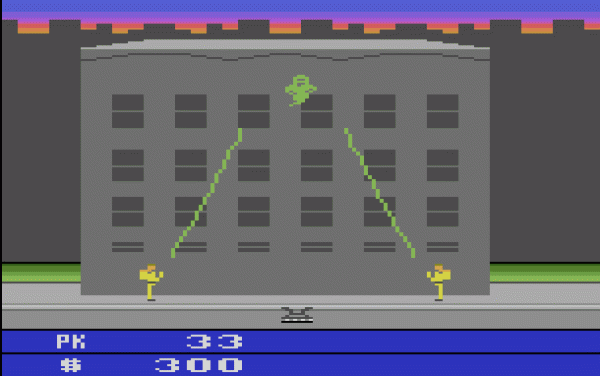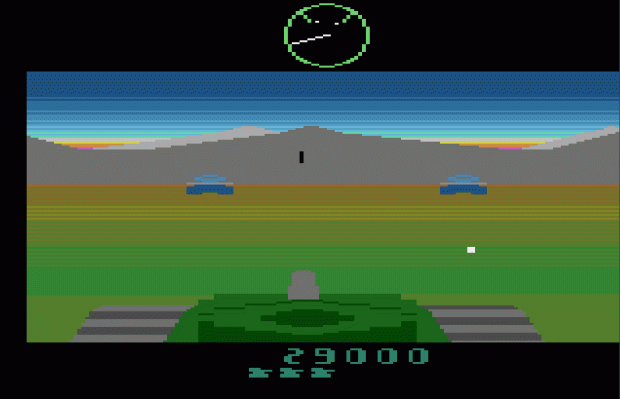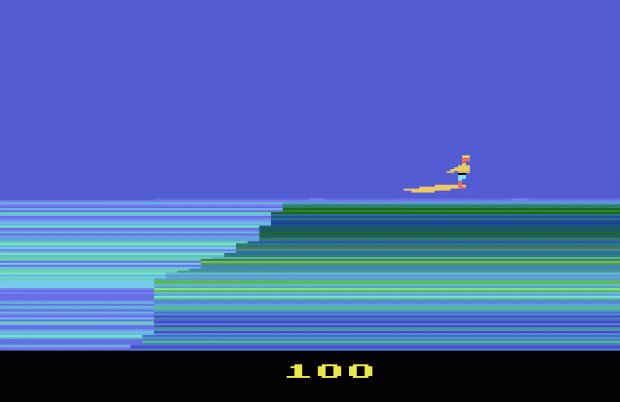The Atari 2600 is by far the longest-lasting console in video game history. Arriving on the market in 1977, it was not discontinued until fifteen years later, in 1992. It survived competition from more powerful game consoles, home computers, and even the Great Video Game Crash of 1984. The NES juggernaut may have finally taken the 2600 down, but it still went out with a bang.
Near the end of its run, Atari programmers with a decade of experience under their belts used every software trick and hardware tweak in the book to put out games that truly showed off the awesome potential of the Video Computer System. Looking at these games, you would think they were running on much more powerful hardware. While there’s nothing on the 2600 that matches the complexity of Super Mario Bros. or The Legend of Zelda, they came pretty damn close to Nintendo-quality with these 10 exciting, innovative titles that showed that you didn’t need more than a one-button joystick or 128 bytes of RAM to have a good time.
This list of 10 games represents the state of the art of Atari 2600 programming in the late 1980s. While there are many homebrews that do amazing things with the system, I won’t be covering them in this article. I also won’t be covering any Starpath Supercharger games, even they many of them were incredibly advanced for their time. The Supercharger was a hardware addon to the Atari 2600 that loaded games from cassette tape and had its own RAM and CPU. It’s a completely different thing altogether. It also completely disappeared from the market after the 1984 crash. These ten games run entirely on the stock console, with only the chips the developers could stuff into their cartridges to propel them to video game excellence.
I cover the first five games on my list in this post. The conclusion to the article will be posted in a few days. Enjoy!
10. Ghostbusters (1985, Activision)
“But,” you say, “Doesn’t the ‘Ghostbusters’ video game really suck? I mean, the Angry Video Game Nerd ripped it a new one about fifteen times.” True, it’s repetitive and clunky, and the gameplay hasn’t aged very well. But when you’re six years old, and Ghostbusters is your most favorite film of all time, and all your friends are playing the video game version on their Tandy 1000s and Commodore 64s, and all you have is an Atari 2600, you’d kill to have a piece of that action, even if it was only a piece. The Atari 2600 wasn’t exactly known for very good ports of complex computer games, so I was extremely skeptical when my young self found this cartridge at a swap meet for $1.00. But I would find Ghostbusters on the Atari 2600 to be a surprisingly faithful recreation of the home computer experience. Sure, some details were necessarily left out (like some graphical details, the voice samples, and being able to choose different cars), but the important parts were there, and they blew away my expectations of what the old console could do. You could buy ghost hunting equipment in a menu screen (possibly a first for the 2600!), drive around on a map screen running down ghosts like an 8-bit Tommy Vercetti, and catch Slimers with your ghost traps and proton packs. Graphics (at least in the ghost catching sections) are detailed and well-animated, from the ghosts to the busters to the Ectomobile to the ever-threatening Stay-Puft Marshmallow Man. This is also one of the first and only Atari 2600 games with background music–the Ghostbusters theme plays throughout and is quite listenable. This would set the tone for more high-quality games for the Atari as the competition from Nintendo, Sega, and home computers began to heat up.
9. Jr. Pac-Man (1984, released 1987, Atari)
I first played Jr. Pac-Man in 1987 when my parents bought it for me for Christmas. I had played Pac-Man on my cousin’s 2600 and I desperately wanted my own copy to play. (Hey, I didn’t know it was a crappy game back then, I was like 8 at the time.) But instead of the original Pac-Man, my parents got me Jr. Pac-Man. I was skeptical at first (I mean, come on, it has “Junior” right in the title, so it must be one of those dumb “little kids” games, right?) But when I plugged it into my Atari 2600, my love for Junior’s clunky Pac-papa faded like the desert wind. This was a sequel that completely exceeded the original, with eight huge scrolling mazes, fast-moving, smoothly-animated characters, and sound effects and music that were almost just like those in the arcade! This is the only version of Pac-Man for the 2600 that had the background “wacka-wacka” noise playing throughout, and the dot eating, ghost munching, and death sounds were pleasantly distinctive compared to the dull beeps of 2600 Pac-Man or the grating high-pitched noises of 2600 Ms. Pac-Man.
Jr. Pac-Man and the ghosts looked just like their arcade counterparts and were animated very smoothly. And even though the mazes were blocky and the dots were dashes (like the previous Atari 2600 Pac-Man games), there were eight different ones to roam around in, each with its own theme music that played before the level started. Also each level had its own “fruit,” in this game shaped like toys and other kid-friendly objects like root beer and kittens. These bonus items have an additional property not found in the previous Pac-Man games. The toys will pass over the dots as they travel, turning normal 10-point dots into 50-point dots. However, if they collide with an energizer, both the toy and the energizer will explode (with a nice graphical flourish, I may add.) Eating 50-point dots also makes Jr. Pac-Man slower than eating regular dots, thus making him more vulnerable to the ghosts. This adds a new “risk vs. reward” element to the Pac-Man series: do I hang out and let the toy turn all the dots, and collect all the points? Or do I eat it as soon as possible so it doesn’t destroy my defenses against the ghosts? The choice depends purely on you, and your skill with the Joystick Controller.
The gameplay is extremely challenging, especially with all four ghosts enabled. Since the maze is three times as high as the screen, the ghosts have the ability to hide and sneak up on you if you don’t mentally track every move they make. That, along with the energizer-destroying bonus fruit, make this a uniquely challenging and compelling experience. Even today, this is still one of my favorite games, and I pull it out whenever I need to relive some childhood memories… or start finding other games too easy.
8. Pitfall 2: Lost Caverns (1984, Activision)
Released as it was in the height of the Video Game Crash, not very many people got to experience this awesome game when it was new, but thankfully it has received new life on various Activision compilations and the Internet. Hot off the heels of the amazing success of the first Pitfall, one of the highest-selling video games of all time, programmer David Crane pulled out all the stops on this sequel. Not only did Pitfall 2 use a 10 KB ROM, making it more than twice as large as it predecessor, it also included a special Display Processor Chip inside the cartridge, that Crane designed himself, that allowed for greatly improved graphics and sound. (It also made it extremely difficult to emulate Pitfall 2 on PCs for several years, but that’s another story.)
The familiar jungle setting of the original Pitfall opens up onto a gigantic underground labyrinth, the Lost Caverns, that’s 8 screens wide and 27 platforms deep. In other words, if you fall off the stairs in the first part of the game, it’s a long way down to the bottom. In addition to gathering treasure, Pitfall Harry must rescue his niece Rhonda and pet cat Quickclaw, hidden somewhere in the caverns. Unlike the procedurally generated levels of the first game, where you’d see the same six or seven screens over and over again, each part of the caverns is different and has its own challenges you must discover in order to pass them. Pitfall Harry can now swim as well as soar through the air with the help of a balloon.
The graphics and sound are where Pitfall II really soars. Everything is bright and colorful. Pitfall Harry runs and jumps with fluid motion. The water he swims through sloshes around realistically. The various bats, birds, scorpions and frogs that block Harry’s path have their own distinctive animation styles and attack patterns. If you weren’t looking carefully, you might confuse this for a Commodore 64 or an early NES game. The DPC chip not only boosted this game’s graphics, it enabled a four-voice background theme song that’s quite possibly one of the most catchy and memorable video game tunes this side of Nobuo Uematsu. The music even changed subtly as you were playing. When you started playing, the theme music would start out a fast, peppy “heroic” version of the song which would then slow to a more atmospheric tune. If you picked up a treasure, the music would speed up again, but if you got hit by an enemy, the song would turn into a slow, minor key “funeral dirge” until you picked up another treasure.
Pitfall II was also one of the first games to do away with the concept of “lives” and “game overs,” replacing them with a checkpoint system that was ahead of its time. In the caverns Pitfall Harry will run over red crosses on the ground. When Pitfall Harry collides with an enemy, he is dragged back, as if by some unseen hand, to the last cross he touched, losing points based on how far the checkpoint is from where he “died.” You can continue playing indefinitely without having to start from scratch each time you fall. This goes a long way towards reducing the frustration of the game, even if it doesn’t do much for the game’s difficulty (grrr bats!)
This innovative game showed what platform games were capable of and paved the way for an entirely new genre. Our favorite Japanese-Italian plumber Mario wouldn’t be running, jumping, and floating through massive multi-screen levels for at least another year. Who knows, if the crash hadn’t happened, maybe Pitfall Harry would be as big a star in the video game world.
7. Battlezone (1983, Atari)
Arcade-goers around the world were amazed by the original Battlezone in 1980. One of the very first “first-person shooters,” this vector-based arcade game transported players into a fully-realized 3-D world where they could pilot a tank and defend themselves against enemy tanks and other dangers. The programmers of the Atari 2600 port had to by necessity leave out a lot of the stuff that made the arcade game so unique, but what they left in impressed the heck out of Atari 2600 fans back in 1983. Gone were the polygonal objects that dotted the arcade landscape, but the 2600 version used alternating lines of brilliant color to give the playfield an illusion of depth and movement. No erupting volcano in the background; instead, you got a beautiful sunset peeking out of a horizon of gray mountains in the distance. It’s kind of like the sunset effect in Activision’s Barnstorming. You almost wish you could just sit there and enjoy a pleasant evening. But no, you can’t do that, there’s an infinite amount of enemy tanks, flying saucers, and cruise missiles popping out of nowhere to kick your ass. And unlike the arcade game, they come after you two at a time. The enemies are likewise highly detailed (for their time) and unlike earlier attempts at 3D on the VCS like Star Ship and Air Raiders, you can actually tell what direction they’re coming at by how they’re pointed on the screen. This actually makes Battlezone feel like a game where you’re actually moving in free space, rather than in some kind of shooting gallery. The combination of great graphics and innovative gameplay made Battlezone one of the top games in the 2600 library and made gamers anticipate the new 3D worlds that would follow in the decades to come.
6. California Games (1988, Epyx)
California Games is essentially a minigame collection, with four games based on what we now call “Extreme Sports”: Footbag, Half Pipe, BMX, and Surfing. The home computer and NES versions of California Games had six games, but by cutting out Flying Disk and Skating, the developers were able to cram every last bit of detail and fun into the remaining four. Each of these games would have probably received their own cartridges back in the early 1980s, as they are that good.
Footbag (or “hackeysack” as it is more commonly known) is set in a verdant forest in San Francisco with fluffy white clouds moving through an azure sky. Your player character is a multi-colored and huge sprite with fully articulated arms and legs. The graphics in this part of the game could easily pass for a Atari 7800 or even a Commodore 64 title. The controls are quick and fluid, and you can do a number of different tricks just with the joystick and one button.
The Half Pipe section is in my opinion the weakest of the four games, but it’s got a neat Hollywood sign in the background, and you can do a wide variety of skateboarding moves to boost your score, a whole decade before Tony Hawk made skateboarding games into a genre.
The BMX racing section is a multi-screen descent down a Mojave Desert mountain that has you jumping over pine trees and cartwheeling over cow skulls. The action is fast and furious and almost resembles a NES-era platform game, or a prototype version of Line Rider.
And the surfing section had you hangin’ ten on an amazing wave effect I haven’t seen on any surfing game before or since.
Another neat feature of the game is that up to eight players can play, by passing the joystick around. So this is also one of the first party games. And nothing puts a party in your Atari 2600 quite like Epyx California Games.









Great article! Thanks!